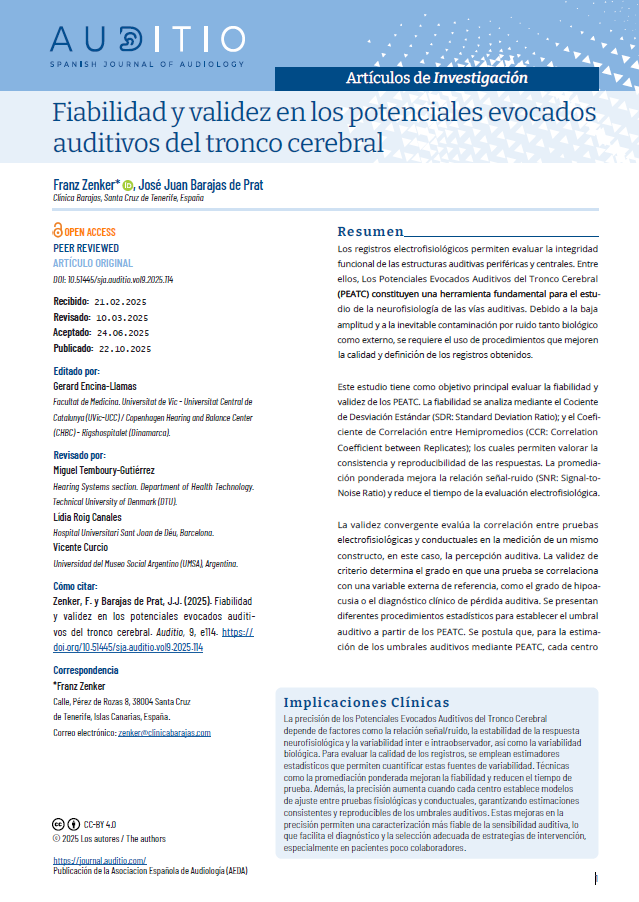Fiabilidad y validez en los potenciales evocados auditivos del tronco cerebral
DOI:
https://doi.org/10.51445/sja.auditio.vol9.2025.114Palabras clave:
Potenciales Evocados Auditivos del Tronco Cerebral, fiabilidad, validez, sensibilidad, especificidadResumen
Los registros electrofisiológicos permiten evaluar la integridad funcional de las estructuras auditivas periféricas y centrales. Entre ellos, los Potenciales Evocados Auditivos del Tronco Cerebral (PEATC) constituyen una herramienta fundamental para el estudio de la neurofisiología de las vías auditivas. La baja amplitud de la señal registrada y la presencia de ruido requieren el uso de procedimientos que optimicen la calidad y definición de los registros obtenidos.
Este estudio se centra en la evaluación de la fiabilidad y validez de la actividad cerebral registrada, aspectos esenciales para garantizar la calidad de la medida. La fiabilidad se analiza mediante indicadores como el cociente de desviación estándar (SDR) y el coeficiente de correlación entre hemipromedios (CCR), los cuales permiten valorar la consistencia y reproducibilidad de las respuestas. La aplicación de técnicas de promediación ponderada optimiza la relación señal/ruido, lo que permite obtener registros más estables y precisos.
La validez convergente evalúa la correlación entre pruebas electrofisiológicas y conductuales en la medición de un mismo constructo, en este caso, la percepción auditiva. Por otro lado, La validez de criterio evalúa el grado en que una prueba se asocia con una medida de referencia establecida, como un diagnóstico clínico de pérdida auditiva. Este estudio revisa la utilidad de los PEATC en la estimación del umbral auditivo, analizando su sensibilidad y especificidad para detectar la presencia de pérdida auditiva. Asimismo, se examinan diversas estrategias metodológicas orientadas a optimizar la calidad de los registros, cuya implementación contribuye a mejorar la precisión diagnóstica.
Descargas
Visibility and Altmetrics
Métricas
Estadísticas globales ℹ️
|
10
Visualizaciones
|
10
Descargas
|
|
20
Total
|
|
Citas
Bagatto, M., Moodie, S., Scollie, S., Seewald, R., Moodie, S., Pumford, J., & Liu, K. P. R. (2005). Clinical Protocols for Hearing Instrument Fitting in the Desired Sensation Level Method. Trends in Amplification, 9(4), 199–226. https://doi.org/10.1177/108471380500900404 DOI: https://doi.org/10.1177/108471380500900404
Bagatto, M., Scollie, S. D., Hyde, M., & Seewald, R. (2010). Protocol for the provision of amplification within the Ontario Infant hearing program. International Journal of Audiology, 49(SUPPL. 1), 70–80. https://doi.org/10.3109/14992020903080751 DOI: https://doi.org/10.3109/14992020903080751
Barajas, J. J. (1982). Evaluation of ipsilateral and contralateral brainstem auditory evoked potentials in multiple sclerosis patients. Journal of the Neurological Sciences, 54(1), 69–78. https://doi.org/10.1016/0022-510X(82)90219-2 DOI: https://doi.org/10.1016/0022-510X(82)90219-2
Barajas, J. J. (1985). Brainstem Response Audiometry as Subjective and Objective Test for Neurological Diagnosis. Scandinavian Audiology, 14(1), 57–62. https://doi.org/10.3109/01050398509045923 DOI: https://doi.org/10.3109/01050398509045923
Barajas, J. J., Olaizola, F., Tapia, M. C., Alarcon, J. L., & Alaminos, D. (1981). Audiometric Study of the Neonate: Impedance Audiometry. Behavioural Responses and Brain Stem Audiometry. International Journal of Audiology, 20(1), 41–52. https://doi.org/10.3109/00206098109072681 DOI: https://doi.org/10.3109/00206098109072681
Barajas de Prat, J., Zenker Castro, F., & Fernández Belda, R. (2007). Potenciales Evocados Auditivos. In C. Suárez & L. M. Gil Carcedo (Eds.), Tratado de Otorrinolaringología y Patología de Cabeza y Cuello (Vol. 6, Issue 5, pp. 1133 – 1155). Editorial Médica Panamericana, S.A.
Berninger, E., Olofsson, Å., & Leijon, A. (2014). Analysis of click-evoked auditory brainstem responses using time domain cross-correlations between interleaved responses. Ear and Hearing, 35(3), 318–329. https://doi.org/10.1097/01.aud.0000441035.40169.f2 DOI: https://doi.org/10.1097/01.aud.0000441035.40169.f2
Chalak, S., Kale, A., Deshpande, V. K., & Biswas, D. A. (2013). Establishment of normative data for monaural recordings of auditory brainstem response and its application in screening patients with hearing loss: A cohort study. Journal of Clinical and Diagnostic Research, 7(12), 2677–2679. https://doi.org/10.7860/JCDR/2013/6768.3730 DOI: https://doi.org/10.7860/JCDR/2013/6768.3730
Cone, B., & Norrix, L. W. (2015). Measuring the advantage of kalman-weighted averaging for auditory brainstem response hearing evaluation in infants. American Journal of Audiology, 24(2), 153–168. https://doi.org/10.1044/2015_AJA-14-0021 DOI: https://doi.org/10.1044/2015_AJA-14-0021
Davila, C. E., & Mobin, M. S. (1992). Weighted Averaging of Evoked Potentials. IEEE Transactions on Biomedical Engineering, 39(4), 338–345. https://doi.org/10.1109/10.126606 DOI: https://doi.org/10.1109/10.126606
Dawson, G. D. (1954). A summation technique for the detection of small evoked potentials. Electroencephalography and Clinical Neurophysiology, 6(C), 65–84. https://doi.org/10.1016/0013-4694(54)90007-3 DOI: https://doi.org/10.1016/0013-4694(54)90007-3
Delgado Hernández, J., Zenker Castro, F., & Barajas de Prat, J. J. (2003). Normalización de los Potenciales Evocados Auditivos del Tronco Cerebral I: Resultados en una muestra de adultos normoyentes. Auditio: Revsita Electrónica de Audiología, 2(11), 13–18. https://doi.org/10.51445/sja.auditio.vol2.2003.0020 DOI: https://doi.org/10.51445/sja.auditio.vol2.2003.0020
Doyle, D. J., & Hyde, M. L. (1981). Analogue and digital filtering of auditory brainstem responses. Scandinavian Audiology, 10(2), 81–89. https://doi.org/10.3109/01050398109076166 DOI: https://doi.org/10.3109/01050398109076166
Elberling, C. (1979). Letter to the editor: Auditory electrophysiology: Spectral analysis of cochlear and brain stem evoked potentials. Scandinavian Audiology, 8(1), 57–64. https://doi.org/10.3109/01050397909076302 DOI: https://doi.org/10.3109/01050397909076302
Gorga, M. P., Johnson, T. A., Kaminski, J. K., Beauchaine, K. L., Garner, C. A., & Neely, S. T. (2006). Using a combination of click-and toneburst-evoked auditory brainstem response measurements to estimate pure-tone thresholds. Ear Hear, 27(1), 60–74. https://doi.org/10.1097/01.aud.0000194511.14740.9c DOI: https://doi.org/10.1097/01.aud.0000194511.14740.9c
Hall, J. W. I. (2007). Improving the Signal-to-Noise Ratio (SNR). In New Handbook of Auditory Evoked Responses (1st ed., pp. 95–96). Pearson Education.
Hoke, M., Ross, B., Wickesberg, R., & Lütkenhöner, B. (1984). Weighted averaging - theory and application to electric response audiometry. Electroencephalography and Clinical Neurophysiology, 57(5), 484–489. https://doi.org/10.1016/0013-4694(84)90078-6 DOI: https://doi.org/10.1016/0013-4694(84)90078-6
Kumaragamage, C. L., Lithgow, B. J., & Moussavi, Z. K. (2016). Investigation of a new weighted averaging method to improve SNR of electrocochleography recordings. IEEE Transactions on Biomedical Engineering, 63(2), 340–347. https://doi.org/10.1109/TBME.2015.2457412 DOI: https://doi.org/10.1109/TBME.2015.2457412
Madsen, S. M. K., Harte, J. M., Elberling, C., & Dau, T. (2018). Accuracy of averaged auditory brainstem response amplitude and latency estimates. International Journal of Audiology, 57(5), 345–353. https://doi.org/10.1080/14992027.2017.1381770 DOI: https://doi.org/10.1080/14992027.2017.1381770
McCreery, R. W., Kaminski, J., Beauchaine, K., Lenzen, N., Simms, K., & Gorga, M. P. (2015). The Impact of Degree of Hearing Loss on Auditory Brainstem Response Predictions of Behavioral Thresholds. Ear and Hearing, 36(3), 309–319. https://doi.org/10.1097/AUD.0000000000000120 DOI: https://doi.org/10.1097/AUD.0000000000000120
McKearney, R. M., Bell, S. L., Chesnaye, M. A., & Simpson, D. M. (2023). Optimising weighted averaging for auditory brainstem response detection. Biomedical Signal Processing and Control, 83(August 2022), 104676. https://doi.org/10.1016/j.bspc.2023.104676 DOI: https://doi.org/10.1016/j.bspc.2023.104676
Mühler, R., & von Specht, H. (1997). Reduction of Background Noise in Human Auditory Brainstem Response by Means of Classified Averaging. In Acoustical Signal Processing in the Central Auditory System (pp. 599–604). Springer US. https://doi.org/10.1007/978-1-4419-8712-9_56 DOI: https://doi.org/10.1007/978-1-4419-8712-9_56
Norton, S. J., Gorga, M. P., Widen, J. E., Folsom, R. C., Sininger, Y., Cone-Wesson, B., Vohr, B. R., Mascher, K., & Fletcher, K. (2000). Identification of Neonatal Hearing Impairment: Evaluation of transient evoked otoacoustic emission, distortion product otoacoustic emission, and auditory brain stem response test performance. Ear and Hearing, 21(5), 508–528. https://doi.org/10.1097/00003446-200010000-00013 DOI: https://doi.org/10.1097/00003446-200010000-00013
Núñez Batalla, F., Jáudenes Casaubón, C., Sequí Canet, J. M., Vivanco Allende, A., Zubicaray Ugarteche, J., & Olleta Lascarro, I. (2020). Actualización de los programas de detección precoz de la sordera infantil: recomendaciones CODEPEH 2019 (Niveles 2, 3 y 4: diagnóstico, tratamiento y seguimiento) | Update in early detection of pediatric hearing loss: 2019 CODEPEH recommendations. Revista Española de Discapacidad, 8(1), 219–246. https://doi.org/10.5569/2340-5104.08.01.13 DOI: https://doi.org/10.5569/2340-5104.08.01.13
Picton, T., Linden, R., Hamel, G., & Maru, J. (1983). Aspects of Averaging. Seminars in Hearing, 4(04), 327–340. https://doi.org/10.1055/s-0028-1094195 DOI: https://doi.org/10.1055/s-0028-1094195
Purdy, S. C., Houghton, J. M., Keith, W. J., & Greville, K. A. (1989). Frequency-Specific Auditory Brainstem Responses: Effective Masking Levels and Relationship to Behavioural Thresholds in Normal Hearing Adults. International Journal of Audiology, 28(2), 82–91. https://doi.org/10.3109/00206098909081613 DOI: https://doi.org/10.3109/00206098909081613
Schimmel, H. (1967). The (+) reference: accuracy of estimated mean components in average response studies. Science, 157(784), 92–94. https://doi.org/10.1126/science.157.3784.92 DOI: https://doi.org/10.1126/science.157.3784.92
Stapells, D. R. (2000). Threshold Estimation by the Tone-Evoked Auditory Brainstem Response: A Literature Meta-Analysis. Journal of Speech Language Pathology and Audiology, 24(2), 74–83.
Starr, A., & Rance, G. (2015). Auditory neuropathy. In Handbook of Clinical Neurology (1st ed., Vol. 129). Elsevier B.V. https://doi.org/10.1016/B978-0-444-62630-1.00028-7 DOI: https://doi.org/10.1016/B978-0-444-62630-1.00028-7
Vander Werff, K. R., Prieve, B. A., & Georgantas, L. M. (2009). Infant Air and Bone Conduction Tone Burst Auditory Brain Stem Responses for Classification of Hearing Loss and the Relationship to Behavioral Thresholds. Ear & Hearing, 30(3), 350–368. https://doi.org/10.1097/AUD.0b013e31819f3145 DOI: https://doi.org/10.1097/AUD.0b013e31819f3145
Wang, H., Li, B., Lu, Y., Han, K., Sheng, H., Zhou, J., Qi, Y., Wang, X., Huang, Z., Song, L., & Hua, Y. (2021). Real-time threshold determination of auditory brainstem responses by cross-correlation analysis. IScience, 24(11), 103285. https://doi.org/10.1016/j.isci.2021.103285 DOI: https://doi.org/10.1016/j.isci.2021.103285
Widen, J. E., Folsom, R. C., Cone-Wesson, B., Carty, L., Dunnell, J. J., Koebsell, K., Levi, A., Mancl, L., Ohlrich, B., Trouba, S., Gorga, M. P., Sininger, Y. S., Vohr, B. R., & Norton, S. J. (2000). Identification of Neonatal Hearing Impairment: Hearing status at 8 to 12 months corrected age using a visual reinforcement audiometry protocol. Ear and Hearing, 21(5), 471–487. https://doi.org/10.1097/00003446-200010000-00011 DOI: https://doi.org/10.1097/00003446-200010000-00011
Widen, J. E., Johnson, J. L., White, K. R., Gravel, J. S., Vohr, B. R., James, M., Kennalley, T., Maxon, A. B., Spivak, L., Sullivan-Mahoney, M., Weirather, Y., & Meyer, S. (2005). A Multisite Study to Examine the Efficacy of the Otoacoustic Emission/Automated Auditory Brainstem Response Newborn Hearing Screening Protocol. American Journal of Audiology, 14(2), S205–S216. https://doi.org/10.1044/1059-0889(2005/022) DOI: https://doi.org/10.1044/1059-0889(2005/020)
Wong, P. K., & Bickford, R. G. (1980). Brain stem auditory evoked potentials: The use of noise estimate. Electroencephalography and Clinical Neurophysiology, 50(1–2), 25–34. https://doi.org/10.1016/0013-4694(80)90320-x DOI: https://doi.org/10.1016/0013-4694(80)90320-X
Zenker Castro, F. (2011). Controversias en el diagnóstico y adaptación audioprotésica en pérdidas auditivas severas en niños. Audiol Hoy, 8(1), 65–71.
Zenker Castro, F., Estrada Alonso, M. M., Larumbe Zabala, E., & Barajas De Prat, J. J. (2013). Fiabilidad diagnóstica de los potenciales evocados auditivos del tronco cerebral en una muestra de pacientes en edad infantil. Actas Del IX Congreso de La Asociación Española de Audiología, 153–159.

Publicado
Cómo citar
Licencia
Derechos de autor 2025 Franz Zenker, José Juan Barajas de Prat

Esta obra está bajo una licencia internacional Creative Commons Atribución 4.0.
Todos los artículos serán publicados bajo la licencia abierta Creative Commons Attribution (CC-BY). Esta licencia permite a otros compartir y adaptar el contenido, incluso con fines comerciales, siempre que se dé el reconocimiento adecuado a los autores y a la revista. Al enviar su manuscrito, los autores retienen los derechos de autor pero otorgan a la revista el derecho a realizar la primera publicación bajo esta licencia.
Más información sobre esta licencia disponible en: https://creativecommons.org/licenses/by/4.0/
Publicaciones 2001-2020
Los textos publicados en esta revista en la seccion de "AUDITIO 2001-2020 están sujetos –si no se indica lo contrario– a una licencia de Reconocimiento 3.0 España de Creative Commons. Puede copiarlos, distribuirlos, comunicarlos públicamente, hacer obras derivadas y usos comerciales siempre que reconozca los créditos de las obras (autoría, nombre de la revista, institución editora) de la manera especificada por los autores o por la revista. La licencia completa se puede consultar en http://creativecommons.org/licenses/by/3.0/es/deed.es.








 AUDITIO | Spanish Journal of Audiology
AUDITIO | Spanish Journal of Audiology
